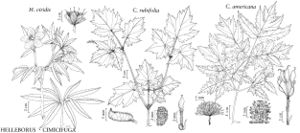Helleborus viridis
Sp. Pl. 1: 557. 1753.
Common names: Green hellebore
Selected by author to be illustratedIntroduced
Treatment appears in FNA Volume 3.
Revision as of 20:33, 26 July 2019 by FNA>Volume Importer
Herbs, 1.2-3.5 dm. Stems fluted and ridged. Leaves 2-5 or more; basal leaves with petioles to 30cm; blades to 40cm wide, lobes 6-15, 2-cleft or incised, 6-21 × 1.5-4.2 cm, margins sharply serrate; cauline leaves similar to basal but smaller, sessile or short-petioled. Inflorescences: peduncles 2-5 cm. Flowers pendent, 35-60 mm diam.; sepals scarcely imbricate, 9-20 mm wide; petals upwardly curved, cornucopia-like with involute margins. Follicles 3-6, connate at base, swollen; body 14-25 mm; beak persistent.
Phenology: Flowering winter–early spring (Dec–Mar).
Habitat: Waste places, abandoned gardens, shaded roadsides, and calcareous woodlands
Elevation: 0-400m
Distribution

Ill., Md., Mich., N.J., N.Y., Ohio, Pa., W.Va., Europe
Discussion
This species is not as commonly planted as it once was, and most records are old.
Selected References
None.
Lower Taxa
None.
